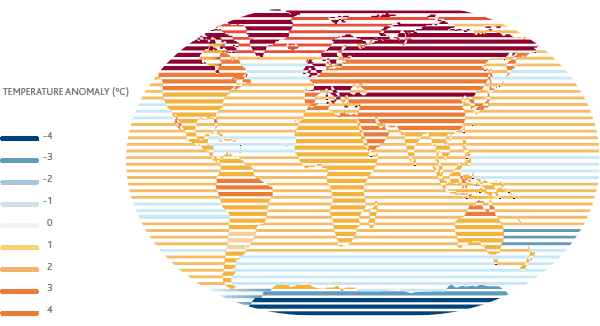Decarbonisation and climate change
2016 was the year that the strategy undertaken internationally for creating and developing a carbon free economy was confirmed. Snam is committed to promoting the use of natural gas in various business segments with the aim of fighting climate change.
NASA and the NOAA (National Oceanic and Atmospheric Administration) have certified 2016 as the warmest year on record globally since 1880, when record keeping began. The earth’s surface temperature was 0.94 degrees centigrade higher than the average for the 20th century. This is the highest figure ever recorded, overtaking previous records for 2014 and 2015.
The conclusion of COP22 held in Marrakesh from 7th to 18th November 2016, under the scope of the United Nations Framework Convention on Climate Change, reflected the wave of optimism created by the simultaneous entry into force of the Paris Agreement within less than a year of its adoption.
GLOBAL MEAN SURFACE TEMPERATURE (GISS) JANUARY-JUNE 2016

This journey, if compared with the entry into force of the Kyoto protocol (2005), twelve years after it became effective, demonstrates a different level of reaction by the international community and reflects the extent of the level of awareness and concern about the increase in global warming. This prompted the 196 countries that took part in COP22, through the “Marrakesh Proclamation”, to strengthen the commitments undertaken in the Paris Agreement (COP21) and support their irreversibility.
With Paris first and later Marrakesh, the era of decarbonisation has finally begun, changing outlooks especially in adopting production and consumption models that prioritise the efficient use of resources and should be organised to ensure the ending of the entire usage cycle with their eventual recovery, in compliance with the principles of a circular economy.
The drive towards decarbonisation is already influencing energy production methods and its use, accelerating the route to carbon neutrality which the Paris Agreement set as the goal to be reached by the second half of this century.
The path mapped out does not involve changes of direction and the efforts required must come from all sections of society and the economy with global action at all levels and needs to take place through all means to ensure development aimed at protecting the environment, social equality and economic sustainability.
There are two processes which involve energy sustainability at European level:
- the implementation of the 2030 Climate and Energy Package, to reduce environmental pollution by at least 40% compared with the 1990 figures;
- the gradual construction of the Energy Union, a structured journey which, in addition to the decarbonisation of the economy, also includes four dimensions aligned with the Sustainable Development Goals:
- energy security;
- market integration;
- energy efficiency;
- research, innovation and competitiveness.
The Paris and Marrakesh climate agreements
Urgent commitments
The increase in the global temperature should be contained within 2° compared with the figures of the pre-industrial era, striving to remain at +1.5°. To achieve the objective, emissions must start to fall from 2020.
Global consensus
As well as Europe, China, India and the United States, the three countries which produce the most pollution on earth, are also committed to cutting emissions.
Five-yearly checks
In 2018, member countries will already be asked to improve cuts in emissions in order to be ready for 2020. The first five-year check will therefore be in 2023.
Funds for clean energy
These should be made available by 2020 to promote green technologies and the decarbonisation of the economy worldwide. A new financial target will be set in 2025 at the latest. Private investors and funds can also contribute.
Compensation for the most vulnerable countries
The agreement launches a compensation mechanism for losses caused by climate change in the most geographically vulnerable countries, which are often also the poorest.

